Abstract: This article documents the discovery of Large Tortoiseshell larvae on the Isle of Portland in June 2021, with the intent of providing several clues for those looking to relocate larvae in subsequent years, as well as encourage observers to find the resulting adults in the summer of 2021.
In 2020, Will Langdon, a PhD student at Oxford University, managed to track down the larval feeding damage of the Large Tortoiseshell on the Isle of Portland, with several sightings of overwintered adults coming from this part of the world in the early spring of 2021. If 2020 was the appetiser, then 2021 is proving to be the main course, with evidence of breeding noted from Sheringham Park in Norfolk (although full details have yet to be divulged), Sussex (ditto) and, as this article shows, on the Isle of Portland once again. Interestingly, the Sheringham Park sighting includes a female egg laying on Goat Willow Salix caprea rather than a species of elm.
Please note that, due to the sensitive nature of Large Tortoiseshell sightings, no detailed site information is provided below. However, we would like to encourage enthusiasts to look out for adults this year, and to report them to their local county recorder.
I was fortunate to be able to join Will and Matthew Oates on 8th June for a recce on the Isle of Portland, with a singular focus on the elms that we felt could play host to the Large Tortoiseshell larvae we were hoping to find, although we were uncertain of the timing, given the particularly cool May and the impact that this would have on the rate of larval development.
Our search started in areas where adults had been seen earlier in the year, with larval webs of the Lackey moth getting the heart racing on several occasions, given that they leave similar feeding damage to early instar Large Tortoiseshell larvae, although they create a much denser web when seen close up.
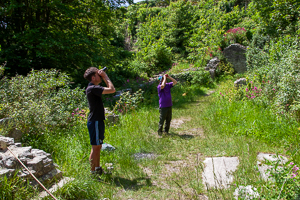 |
| Will and Matthew scanning elms Image © Peter Eeles |
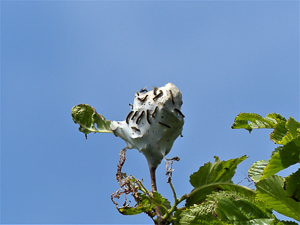 |
| Lackey moth larval web Image © Matthew Oates |
To cut a very long story short, after seven hours of craning our necks looking up at just about every elm on the island (at least if felt like it, having started at 10 am and it was now 5 pm!), we decided to 'call time' and started to pack up our cars to head home, feeling somewhat deflated. Like all good entomologists, Will decided to take one last look at some nearby elms that we'd already surveyed from below, where we had drawn a blank. Incredibly, the different angle was enough for Will's eye to be caught by two groups of orange-spined larvae resting on the upper surface of the elms. Matthew and I were soon on the scene and, with binoculars and long lenses to hand, the consensus was that we were looking at home-grown Large Tortoiseshell larvae. We could even make out that they were late fourth instar, with a few that had already moulted into their fifth and final instar - it turned out that we had, in fact, timed the trip perfectly with our search helped by both the size of the larvae and fourth instar larval feeding damage. Suffice to say, we spent some time looking at the two groups, and were even able to make out each major larval web that had been created by each instar (much like we can with Peacock and Small Tortoiseshell larvae), and use these to track back to the position of the egg batch that would appear almost white as the light reflected on the uneaten egg shells.
 |  |
| The first two groups were found high up Image © Peter Eeles | The first two groups Image © Peter Eeles |
| Video © Peter Eeles |
Incredibly, after we'd gorged ourselves on this feast for the eyes, we found another group of larvae just a few metres away that had developed from a completely separate egg batch. We were able to get much closer to this group and it was clear that the majority were in their fourth instar and preparing to moult, with a few that had already changed skin and were now in their fifth and final instar.
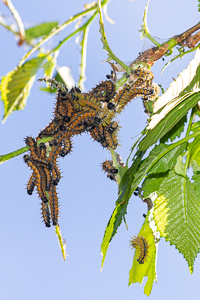 |
| Larvae from the second egg batch Image © Peter Eeles |
The position of these larval groups was similar to the previous year - with the butterfly (and, interestingly, the Lackey moth) preferring sheltered foliage in a particularly warm spot with a south-facing aspect. The foliage itself also comprised relatively vigorous and young growth that showed no 'browning' of the leaves caused by salt spray, which seemed to particularly affect elms growing near the shoreline.
Being butterfly obsessives, we really wanted to make these findings 'count' and, in particular, provide inspiration to those also looking to track down the immature stages of this butterfly and, ultimately, work on a method for surveying for Large Tortoiseshell larvae that could be applied in nearby Weymouth, for example, which has a good population of elms present. And so Will and I made a return visit to Portland on 17th June, although we knew that we were unlikely to find any larvae which would, after an extensive period of wandering, have gone off to pupate in a suitable location - despite looking we failed to find any pre-pupation larvae or pupae. Once we were certain that there were no larvae present, we removed the branches containing the larval feeding damage and were able to create an extensive set of images that may help others. Unsurprisingly, the majority of larval feeding damage had taken place between our two visits, when the final instar larvae had stripped bare several sprigs of elm. Our conclusion, however, was that there was quite a narrow window to undertake such a search, when both the size of the larvae and their feeding damage was 'optimal', and that the timing is very much dependent on spring weather. We found fourth instar larvae on 8th June, but in the hot spring of 2020, one solitary final instar larva was found wandering (presumably in search of a pupation site) on 2nd June, in Weymouth, with Will finding an empty web on Portland on 14th June. We therefore estimated that 2021 was around two weeks behind 2020.
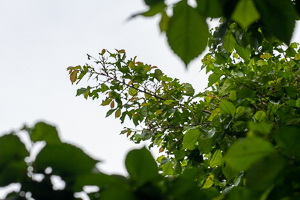 |
| 5th instar larval feeding damage from egg batch 1, seen from below Image © Peter Eeles |
As mentioned above, the first two groups of larvae that were found had developed from the same batch of eggs.
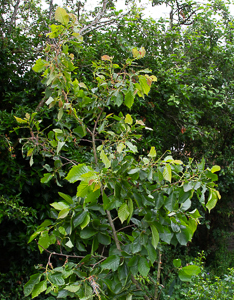 |  |
| Batch 1 Image © Peter Eeles | Batch 1 (annotated) Image © Peter Eeles |
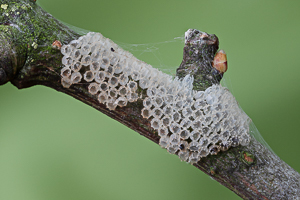 |
| Egg Batch Image © Peter Eeles |
 |
| 2nd instar larval skins Image © Peter Eeles |
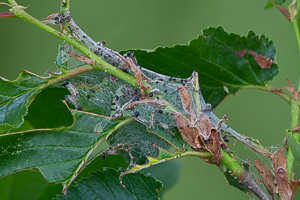 |
| 3rd instar larval skins Image © Peter Eeles |
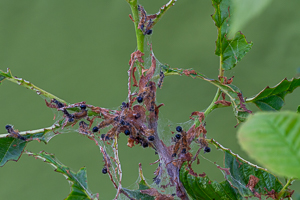 |
| 4th instar larval skins Image © Peter Eeles |
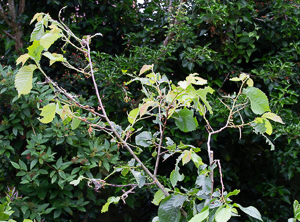 | 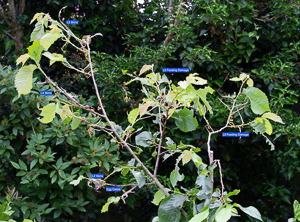 |
| Batch 2 Image © Peter Eeles | Batch 2 (annotated) Image © Peter Eeles |
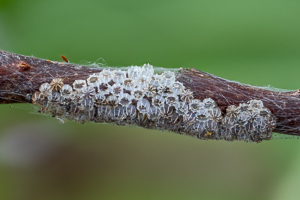 |
| Egg Batch Image © Peter Eeles |
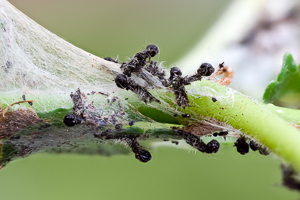 |
| 2nd instar larval skins Image © Peter Eeles |
 |
| 3rd instar larval skins Image © Peter Eeles |
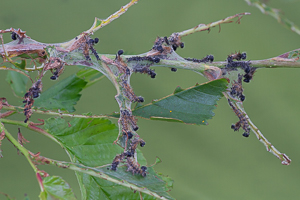 |
| 4th instar larval skins Image © Peter Eeles |
 |
| 4th instar larval skins (close up) Image © Peter Eeles |
We've also had the opportunity to come up with some preliminary measurements that may be of interest, as follows:
| Egg Batch 1 | Egg Batch 2 | |
| # Eggs | 132 | 113 |
| Height from ground | 8-10 m | 4 m |
| # 2nd instar skins | 19 | 18 |
| # 3rd instar skins | 31 | 30 |
| # 4th instar skins | 51 | 39 |
| Distance travelled from egg to 2nd instar web | 9.4 cm | 4.5 cm |
| Distance travelled from 2nd instar web to 3rd instar web | 49.7 cm | 74.2 cm |
| Distance travelled from 3rd instar web to 4th instar web | 102 cm and 141.5 cm (there are 2 groups) | 49.4 cm |
This article is very much preliminary, with several unanswered questions, as discussed below.
Given the proximity of the two egg batches (with no batches found elsewhere on the island), and the number of eggs laid, the general consensus is that this is the work of a single female that was either disturbed while laying, or rested between bouts of laying her eggs.
The observant reader will notice that no measurements are given regarding the number of first instar skins, or the distance travelled from the egg to the first instar web. This is because no first instar skins were found, only head capsules (found in the second instar webbing). There are a few obvious theories for this lack of first instar skins:
It seems that skins are lost from the webbing over time.
My personal thanks go to Will and Matthew for their excellent company as well as comments on this article. Will, Matthew and I would like to explicitly thank Gerry Hinde who provided access to his elm-rich land while we surveyed Portland.